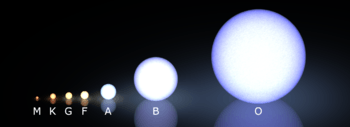YBP 1194
| Observation data Epoch J2000.0 Equinox J2000.0 | |
|---|---|
| Constellation | Cancer |
| Right ascension | 08h 51m 00.807s |
| Declination | +11° 48′ 52.76″ |
| Apparent magnitude (V) | 14.61 |
| Characteristics | |
| Spectral type | G5V |
| B−V color index | 0.626 |
| Astrometry | |
| Radial velocity (Rv) | +36.5 ± 0.9 km/s |
| Details | |
| Mass | 1.01 ± 0.02 M☉ |
| Surface gravity (log g) | 4.44 ± 0.035 [1] cgs |
| Temperature | 5780 ± 27 [1] K |
| Metallicity | 0.023 ± 0.015 [1] |
| Age | 4.2 ±1.6[1] Gyr |
| Other designations | |
NGC 2682 YBP 1194, ES 4063, ES IV-63, FBC 2867, MMJ 5357, SAND 770, 2MASS J08510080+1148527 | |
| Database references | |
| SIMBAD | data |
YBP 1194 is a G-type main-sequence star, class G5V, in the open cluster M67 in the constellation Cancer.[2][3] It is the best solar twin found to date, having the near temperature and mass as our sun. YBP 1194 has a higher metallicity than the Sun. YBP 1194 is .5 billion years younger than the Sun at an age of 4.2 billion years old, but due to the distance, the error bar is high at ±1.6 billion years. On December 19, 2013, it was announced to have an extrasolar planet with a period of 6.9 days, and a high eccentricity of 0.24 with a mass of 0.34 MJ.[3]YBP 1194 is about 2,772 light-years (850 parsecs) from the Sun.[4][5] YBP 1194 is packed in a small cluster, M67-NGC 2682, with a radius 10 ly, with over 500 other stars.[6] For comparison the Sun has 17 stars at a distance of 10 ly and about 134 stars at a distance of 20 ly.[7][8]
Exoplanets
Exoplanet YBP 1194 b was discovered in January 2014 by researchers at the European Southern Observatory (ESO) when three new planets were discovered in the M67 cluster, one of them orbiting YPB 1194, showing that open star clusters are more likely to have planets orbiting them than originally thought. The exoplanet is prominently about 100 times the mass of Earth. Exoplanet YBP 1194 b when compared to the Sun-Earth, orbits the star about 87 million miles closer than planet Mercury. The orbital eccentricity of YPB 1194 b is 0.24, close to Pluto's eccentricity of 0.24905.[3][9] The composition of these planets is currently, unknown.[3][10]
| Companion (in order from star) |
Mass | Semimajor axis (AU) |
Orbital period (days) |
Eccentricity | Inclination | Radius |
|---|---|---|---|---|---|---|
| b | 0.34 MJ | 0.0716 | 6.9 | 0.24 | — | — |
Sun comparison
This chart compares the sun to YBP 1194.
| Identifier | J2000 Coordinates | Distance (ly) |
Stellar Class |
Temperature (K) |
Metallicity (dex) |
Age (Gyr) |
Notes | |
|---|---|---|---|---|---|---|---|---|
| Right ascension | Declination | |||||||
| Sun | — | — | 0.00 | G2V | 5,778 | +0.00 | 4.6 | [11] |
| YBP 1194 [12] | 08h 51m 00.8s | +11° 48′ 53″ | ~2,772 | G5V | 5,780 | +0.023 | 4.2 | [13] |
To date no solar twin with an exact match as that of the Sun has been found, however, there are some stars that come very close to being identical to that of the Sun, and are such considered solar twins by the majority of the public. An exact solar twin would be a G2V star with a 5,778K temperature, be 4.6 billion years old, with the correct metallicity and a 0.1% solar luminosity variation.[14] Stars with an age of 4.6 billion years are at the most stable state. Proper metallicity and size are also very important to low luminosity variation.[15][16][17]

References
- 1 2 3 4 "Confirmed Exoplanet Overview". exoplanetarchive. Retrieved 4 March 2016.
- ↑ "Cl* NGC 2682 YBP 1194". SIMBAD. Centre de Données astronomiques de Strasbourg. Retrieved 4 March 2014.
- 1 2 3 4 David Dickinson (January 15, 2014). "New exoplanet discoveries in open star cluster". Postmedia News. Retrieved March 4, 2014.
- ↑ Brucalassi, A.; Pasquini, L.; Saglia, R.; et al. (2014). "Three planetary companions around M 67 stars". Astronomy & Astrophysics. 561: L9. arXiv:1401.4905
 . Bibcode:2014A&A...561L...9B. doi:10.1051/0004-6361/201322584.
. Bibcode:2014A&A...561L...9B. doi:10.1051/0004-6361/201322584. - ↑ Department of Physics and Astronomy, Division of AstronomyUppsala University, M67-1194, an unusually Sun-like solar twin in M67, by A. Önehag1, A. Korn1, B. Gustafsson1, E. Stempels1 and D. A. VandenBerg2, April 2011
- ↑ M67 Cluster
- ↑ Sol Station Company, Stars Stars within 10 light-years
- ↑ Sol Station Company, Stars Stars within 20 light-years
- ↑ "Rare Planet Discovered Orbiting Twin of Earth's Sun in Star Cluster". January 15, 2014. Retrieved March 4, 2014.
- ↑ exoplanets.org, M 67 YBP 1194 b
- ↑ Williams, D.R. (2004). "Sun Fact Sheet". NASA. Retrieved 2009-06-23.
- ↑ Cl* NGC 2682 YBP 1194 at SIMBAD - Ids - Bibliography - Image.
- ↑ A. Önehag; A. Korn; B. Gustafsson; E. Stempels; D. A. VandenBerg (2011). "M67-1194, an unusually Sun-like solar twin in M67". Astronomy and Astrophysics. 528: A85. arXiv:1009.4579
 . Bibcode:2011A&A...528A..85O. doi:10.1051/0004-6361/201015138.
. Bibcode:2011A&A...528A..85O. doi:10.1051/0004-6361/201015138. - ↑ NASA, Science News, Solar Variability and Terrestrial Climate, Jan. 8, 2013
- ↑ University of Nebraska-Lincoln astronomy education group, Stellar Luminosity Calculator
- ↑ National Center for Atmospheric Research, The Effects of Solar Variability on Earth's Climate, 2012 Report
- ↑ Most of Earth’s twins aren’t identical, or even close!, by Ethan on June 5, 2013